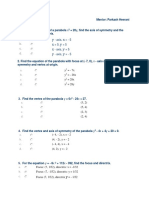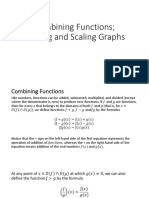Hidden Quadratic Equations
Hidden Quadratic Equations
Uploaded by
FLORECopyright:
Available Formats
Hidden Quadratic Equations
Hidden Quadratic Equations
Uploaded by
FLOREOriginal Description:
Copyright
Available Formats
Share this document
Did you find this document useful?
Is this content inappropriate?
Copyright:
Available Formats
Hidden Quadratic Equations
Hidden Quadratic Equations
Uploaded by
FLORECopyright:
Available Formats
Hidden Quadratic Equations
So the "Standard Form" of a Quadratic Equation is
ax2 + bx + c = 0
But sometimes a quadratic equation doesn't look like that!
For example:
In disguise
x2 = 3x -1
2(w2 - 2w) = 5
z(z-1) = 3
5 + 1/x - 1/x2 = 0
Move all terms to left hand side
Expand (undo the brackets),
and move 5 to left
Expand, and move 3 to left
Multiply by x2
In Standard Form
x2 - 3x + 1 = 0
a, b and c
a=1, b=-3, c=1
2w2 - 4w - 5 = 0
a=2, b=-4, c=-5
z2 - z - 3 = 0
5x2 + x - 1 = 0
a=1, b=-1, c=-3
a=5, b=1, c=-1
_________________________________________________________
How To Solve It?
The "solutions" to the Quadratic Equation are where it is equal to zero.
There are usually 2 solutions (as shown in the graph above).
They are also called "roots", or sometimes "zeros"
There are 3 ways to find the solutions:
1. We can Factor the Quadratic (find what to multiply to make the Quadratic Equation)
2. We can Complete the Square, or
3. We can use the special Quadratic Formula:
Just plug in the values of a, b and c, and do the calculations.
We will look at this method in more detail now.
__________________________________________________________
About the Quadratic Formula
Plus/Minus
First of all what is that plus/minus thing that looks like ?
The means there are TWO answers:
Here is why we can get two answers:
But sometimes we don't get two real answers, and the "Discriminant" shows why.
__________________________________________________________
Discriminant
Do you see b2 - 4ac in the formula above? It is called the Discriminant, because it can "discriminate"
between the possible types of answer:
when b2 - 4ac is positive, we get two Real solutions
when it is zero we get just ONE real solution (both answers are the same)
when it is negative we get two Complex solutions
Complex solutions? Let's talk about them after we see how to use the formula.
__________________________________________________________
Using the Quadratic Formula
Just put the values of a, b and c into the Quadratic Formula, and do the calculations.
Example: Solve 5x + 6x + 1 = 0
Coefficients are: a = 5, b = 6, c = 1
Quadratic Formula: x = [ -b (b2-4ac) ] / 2a
Put in a, b and c: x = [ -6 (62-451) ] / (25)
Solve: x = [ -6 (36-20) ]/10
x = [ -6 (16) ]/10
x = ( -6 4 )/10
x = -0.2 or -1
Answer: x = -0.2 or x = -1
And we see them on this graph.
Check -0.2:
Check -1:
5(-0.2) + 6(-0.2) + 1
= 5(0.04) + 6(-0.2) + 1
= 0.2 -1.2 + 1
=0
5(-1) + 6(-1) + 1
= 5(1) + 6(-1) + 1
=5-6+1
=0
_________________________________________________________
Complex Solutions?
When the Discriminant (the value b2 - 4ac) is negative we get Complex solutions ... what does that mean?
It means our answer will include Imaginary Numbers. Wow!
Example: Solve 5x + 2x + 1 = 0
Coefficients are:
Note that The Discriminant is negative:
Use the Quadratic Formula:
a = 5, b = 2, c = 1
b2 - 4ac = 22 - 451 = -16
x = [ -2 (-16) ] / 10
The square root of -16 is 4i
(i is -1, read Imaginary Numbers to find out more)
So:
x = ( -2 4i )/10
Answer: x = -0.2 0.4i
The graph does not cross the x-axis. That is why we
ended up with complex numbers.
In some ways it is easier: we don't need more calculation, just leave it as -0.2 0.4i.
Is it Quadratic?
Only if it can be put in the form ax2 + bx + c = 0, and a is not zero.
The name comes from "quad" meaning square, as the variable is squared (in other words x2).
These are all quadratic equations in disguise:
In disguise
In standard form
a, b and c
x2 = 3x -1
x2 - 3x + 1 = 0
a=1, b=-3, c=1
2(x2 - 2x) = 5
2x2 - 4x - 5 = 0
a=2, b=-4, c=-5
x(x-1) = 3
x2 - x - 3 = 0
a=1, b=-1, c=-3
5 + 1/x - 1/x2 = 0
5x2 + x - 1 = 0
a=5, b=1, c=-1
__________________________________________________________
How Does this Work?
The solution(s) to a quadratic equation can be calculated using the Quadratic Formula:
The "" means you need to do a plus AND a minus, so there are normally TWO solutions !
The blue part (b2 - 4ac) is called the "discriminant", because it can "discriminate" between the possible types
of answer. If it is positive, you will get two real solutions, if it is zero you get just ONE solution, and if it is
negative you get complex solutions.
Graphing Quadratic Equations
A Quadratic Equation in Standard Form
(a, b, and c can have any value, except that a can't be 0.)
Here is an example:
The Simplest Quadratic
The simplest Quadratic Equation is:
f(x) = x2
And its graph is simple too:
This is the curve f(x) = x2
It is a parabola.
Now let us see what happens when we introduce the "a" value:
f(x) = ax2
Larger values of a squash the curve
Smaller values of a expand it
And negative values of a flip it upside down
_______________________________________________________________________________________
The "General" Quadratic
Before graphing we rearrange the equation, from this:
f(x) = ax2 + bx + c
To this:
f(x) = a(x-h)2 + k
Where:
h = -b/2a
k = f( h )
In other words, calculate h (=-b/2a), then find k by calculating the whole equation for x=h
_______________________________________________________________________________________
First of all ... Why?
Well, the wonderful thing about this new form is that h and k show us the
very lowest (or very highest) point, called the vertex:
And also the curve is symmetrical (mirror image) about the axis that passes
through x=h, making it easy to graph
______________________________________________________________________________________________
h shows us how far left (or right) the curve has been shifted from x=0
k shows us how far up (or down) the curve has been shifted from y=0
Example: Plot f(x) = 2x2 - 12x + 16
First, let's note down:
a = 2,
b = -12, and
c = 16
Now, what do we know?
a is positive, so it is an "upwards" graph ("U" shaped)
a is 2, so it is a little "squashed" compared to the x2 graph
Next, let's calculate h:
h = -b/2a = -(-12)/(2x2) = 3
And next we can calculate k (using h=3):
k = f(3) = 2(3)2 - 123 + 16 = 18-36+16 = -2
So now we can plot the graph (with real understanding!):
We also know: the vertex is (3,-2), and the axis is x=3
_______________________________________________________________________________________________
From A Graph to The Equation
What if we have a graph, and want to find an equation?
Example: you have just plotted some interesting data, and it looks Quadratic:
Just knowing those two points we can come up with an equation.
Firstly, we know h and k (at the vertex):
(h, k) = (1,1)
So let's put that into this form of the equation:
f(x) = a(x-h)2 + k
f(x) = a(x-1)2 + 1
Then we calculate "a":
We know (0, 1.5) so:
And we know the function (except for a):
f(0) = 1.5
f(0) = a(0-1)2 + 1 = 1.5
Simplify:
f(0) = a + 1 = 1.5
a = 0.5
And so here is the resulting Quadratic Equation:
f(x) = 0.5(x-1)2 + 1
You might also like
- Biochem ACS Study GuideDocument15 pagesBiochem ACS Study GuideSheila Gonzalez100% (1)
- Apotheosis SciFiDocument161 pagesApotheosis SciFiSummon Tufak0% (1)
- Solution:: 3-1 Graphing Quadratic FunctionsDocument58 pagesSolution:: 3-1 Graphing Quadratic FunctionsHasan EserNo ratings yet
- Private Truths, Public Lies. The Social Consequences of Preference Falsification by Timur Kuran (Z-Lib - Org) - 1Document100 pagesPrivate Truths, Public Lies. The Social Consequences of Preference Falsification by Timur Kuran (Z-Lib - Org) - 1Henrique Freitas PereiraNo ratings yet
- A2 Semester 1 Cheat SheetDocument1 pageA2 Semester 1 Cheat Sheetklb925No ratings yet
- Okuma Programs PDFDocument71 pagesOkuma Programs PDFHoang LamNo ratings yet
- Quadratics Scavenger HuntsDocument12 pagesQuadratics Scavenger HuntsYani CastroNo ratings yet
- Exam Report Jun 2012Document12 pagesExam Report Jun 2012MadMerlNo ratings yet
- Quadratic Functions and Linear Equations Modelling PracticeDocument7 pagesQuadratic Functions and Linear Equations Modelling PracticeIlja KuznecovsNo ratings yet
- Graphing Using InterceptsDocument11 pagesGraphing Using InterceptsMario Bacani PidlaoanNo ratings yet
- Desmos Quadratic Activity - Kavya PandyaDocument14 pagesDesmos Quadratic Activity - Kavya PandyaKavya PandyaNo ratings yet
- Quadratic TransformationsDocument7 pagesQuadratic Transformationsapi-297405956100% (1)
- UNIT 2 TEST - Transformations of FunctionsDocument3 pagesUNIT 2 TEST - Transformations of FunctionsMursal NasajNo ratings yet
- 08 1d Identify TransformationsDocument2 pages08 1d Identify TransformationsJulie NavarroNo ratings yet
- MHF 4U Review Package - SurtiDocument8 pagesMHF 4U Review Package - SurtiWhimsical AlterationNo ratings yet
- Lesson 1.5 Algebra - Variables and ExpressionsDocument4 pagesLesson 1.5 Algebra - Variables and ExpressionsGreg SJNo ratings yet
- Math Quadratic EquationsDocument21 pagesMath Quadratic EquationsMaisaroh A. KasbahNo ratings yet
- Practice Paper-01 - MathsDocument6 pagesPractice Paper-01 - Mathssaishankardas.ssdNo ratings yet
- Module 2 - Quadratic Equation & Quadratic FunctionsDocument12 pagesModule 2 - Quadratic Equation & Quadratic FunctionsMohd Rizalman Mohd Ali100% (1)
- Algebra Midterm Exam Study GuideDocument13 pagesAlgebra Midterm Exam Study Guideapi-454610672No ratings yet
- Algebra: Like Signs Make " + " Unlike Signs Make " - "Document2 pagesAlgebra: Like Signs Make " + " Unlike Signs Make " - "SGillespieNo ratings yet
- Practice Exam IBA NonCD Answers Version 2014Document2 pagesPractice Exam IBA NonCD Answers Version 2014jmagomedov_723730930No ratings yet
- Solving Quadratic Equations Using Extracting The Square RootsDocument12 pagesSolving Quadratic Equations Using Extracting The Square Rootsjeidre pamorcaNo ratings yet
- Parabola Focus DirectrixDocument17 pagesParabola Focus DirectrixTeresa NavarreteNo ratings yet
- Quadratic Functions 1Document26 pagesQuadratic Functions 1api-312549818No ratings yet
- Worksheet Mathematics G8Document6 pagesWorksheet Mathematics G8nylxyxzy0411 albNo ratings yet
- Parabola WorksheetDocument9 pagesParabola WorksheetMushtaque Gaju100% (1)
- FactoringDocument4 pagesFactoringJake Gabriel MacalinaoNo ratings yet
- Quadratics, Trigonometric Equation & SeriesDocument214 pagesQuadratics, Trigonometric Equation & SeriesSam VagniNo ratings yet
- Final Exam Mhf4uDocument6 pagesFinal Exam Mhf4uAS - 10SM 811497 Brampton Centennial SSNo ratings yet
- Unit 8 Graphing Solving QuadraticsDocument14 pagesUnit 8 Graphing Solving Quadraticsapi-310051256No ratings yet
- DemoDocument35 pagesDemoAnne Tricia AlmanzorNo ratings yet
- Notes On Succesive DifferntiationDocument14 pagesNotes On Succesive Differntiationloveshot844No ratings yet
- 2018 Practice Final Exam Answer KeyDocument7 pages2018 Practice Final Exam Answer KeySean Lehmar CapariñoNo ratings yet
- Formula Sheet - MathDocument3 pagesFormula Sheet - MathDevansh SharmaNo ratings yet
- Algebra TestDocument10 pagesAlgebra TestNELIA AMARANo ratings yet
- UnitDocument93 pagesUnitprasanthwong100% (1)
- Algebra II Final Exam D PDFDocument6 pagesAlgebra II Final Exam D PDFvpacketbits999No ratings yet
- Cbjemaco 04Document10 pagesCbjemaco 04Fawaz Zaheer100% (1)
- Section 3.3: Quadratic Equations and InequalitiesDocument170 pagesSection 3.3: Quadratic Equations and InequalitiesTim WiseNo ratings yet
- Quadratic Equation 1Document29 pagesQuadratic Equation 1Athena Jane NapolisNo ratings yet
- Functions, Limits, Continuity And: DifferentiabilityDocument6 pagesFunctions, Limits, Continuity And: DifferentiabilityPrietesh PatilNo ratings yet
- Year 4 Algebraic Techniques WorksheetDocument3 pagesYear 4 Algebraic Techniques WorksheetSome RoomsNo ratings yet
- 09.successive DifferentiationDocument13 pages09.successive DifferentiationAshraful Islam BhuyianNo ratings yet
- Unit 2 Test Quadratics ReviewDocument7 pagesUnit 2 Test Quadratics ReviewMichael Zebra100% (1)
- 2 6 1 Inflection PointsDocument4 pages2 6 1 Inflection Pointsapi-299265916No ratings yet
- NTH Term of An Arithmetic SequennceDocument5 pagesNTH Term of An Arithmetic SequennceFrencesNo ratings yet
- Continuity AssignmentDocument5 pagesContinuity AssignmentChauhan DharmendraNo ratings yet
- Quardatic Equation-02-Solved ExamDocument14 pagesQuardatic Equation-02-Solved ExamRaju SinghNo ratings yet
- DE (Exact and Reducible To Exact)Document4 pagesDE (Exact and Reducible To Exact)aman bhatiaNo ratings yet
- Linear First Order PDE: Type 2 Based On Rule II For Solving . .Document9 pagesLinear First Order PDE: Type 2 Based On Rule II For Solving . .Saad Ahmed SazanNo ratings yet
- (13969) Sheet 17 Quadratic Equation BDocument45 pages(13969) Sheet 17 Quadratic Equation BAkshat RoyNo ratings yet
- Math Grade 9Document7 pagesMath Grade 9Pede CasingNo ratings yet
- Combining Functions Shifting and Scaling GraphsDocument50 pagesCombining Functions Shifting and Scaling GraphsUsman BokhariNo ratings yet
- Math Formulas For Class XDocument6 pagesMath Formulas For Class Xravilakra lakraNo ratings yet
- Subject: Analysis Iv Lesson: Connectedness in Metric Spaces by Dr. Satya GoelDocument23 pagesSubject: Analysis Iv Lesson: Connectedness in Metric Spaces by Dr. Satya GoelJeoff Libo-onNo ratings yet
- 3.6-Bilinear Transformation 025506Document17 pages3.6-Bilinear Transformation 025506EEE M.AASTHIKANo ratings yet
- Remainder Theorem WorksheetDocument2 pagesRemainder Theorem WorksheetKetia SimNo ratings yet
- Quadratic Equation: By, Prenisha Sanjel Class-12 C2 Exam Symbol No-77s Ps 7558Document17 pagesQuadratic Equation: By, Prenisha Sanjel Class-12 C2 Exam Symbol No-77s Ps 7558aabhushanNo ratings yet
- Jacobi Method PDFDocument57 pagesJacobi Method PDFRajinder Sanwal100% (1)
- Quadratic EquationDocument14 pagesQuadratic EquationLuzelle AnnNo ratings yet
- Quadratic Equations: Squared DegreeDocument8 pagesQuadratic Equations: Squared DegreeNilo ValeraNo ratings yet
- Differential Equations (Calculus) Mathematics E-Book For Public ExamsFrom EverandDifferential Equations (Calculus) Mathematics E-Book For Public ExamsRating: 5 out of 5 stars5/5 (1)
- ALGEBRA SIMPLIFIED EQUATIONS WORKBOOK WITH ANSWERS: Linear Equations, Quadratic Equations, Systems of EquationsFrom EverandALGEBRA SIMPLIFIED EQUATIONS WORKBOOK WITH ANSWERS: Linear Equations, Quadratic Equations, Systems of EquationsNo ratings yet
- Hypothesis TestingDocument50 pagesHypothesis TestingcliermanguiobNo ratings yet
- Lect5 FSMDocument23 pagesLect5 FSMSangeetha BajanthriNo ratings yet
- Europe 1789 To 1914.. The Age of Industry and Empire. Vol. 4 PDFDocument631 pagesEurope 1789 To 1914.. The Age of Industry and Empire. Vol. 4 PDFAndrijaNo ratings yet
- Steps To Perform For Rolling Forward A Physical Standby Database Using RMAN Incremental BackupDocument6 pagesSteps To Perform For Rolling Forward A Physical Standby Database Using RMAN Incremental BackupSudhar ShanNo ratings yet
- Stray Current Pipeline Corrosion: Created in COMSOL Multiphysics 5.6Document16 pagesStray Current Pipeline Corrosion: Created in COMSOL Multiphysics 5.6Jorge LunaNo ratings yet
- Self Love ReikiDocument10 pagesSelf Love ReikiMarianne MareikiNo ratings yet
- Global Galaxy AI Expert QuizDocument18 pagesGlobal Galaxy AI Expert Quizmcf813221No ratings yet
- Assignment 11: Unit 12 - Week 11Document3 pagesAssignment 11: Unit 12 - Week 11aeroacademicNo ratings yet
- The News Wheel Used Car Inspection ChecklistDocument7 pagesThe News Wheel Used Car Inspection ChecklistTom KentNo ratings yet
- CP&M - Lec 9 Network, AoaDocument56 pagesCP&M - Lec 9 Network, AoayoyokhanyasirNo ratings yet
- Dados IPDocument35 pagesDados IPjonmartins686No ratings yet
- Website Development Proposal Document Power Point PresentationDocument35 pagesWebsite Development Proposal Document Power Point Presentationআশরাফুল অ্যাস্ট্রোNo ratings yet
- A Board Game Designing of Serious Mini Game in Complementary ColorsDocument8 pagesA Board Game Designing of Serious Mini Game in Complementary Colorsjuana8pelaezNo ratings yet
- Switch To e Bill For Free Via Mydigi AppDocument4 pagesSwitch To e Bill For Free Via Mydigi AppAkmar EliasNo ratings yet
- Op. Cit. - Wikipedia, The Free EncyclopediaDocument3 pagesOp. Cit. - Wikipedia, The Free EncyclopediaWolf MoonNo ratings yet
- Acknowledgment: Rahul Ritik 5 Year Int. B.A.LL.B. (Hons.) Madhusudan Law College, CuttackDocument52 pagesAcknowledgment: Rahul Ritik 5 Year Int. B.A.LL.B. (Hons.) Madhusudan Law College, Cuttackrahul1996No ratings yet
- Nus Ar 2003Document78 pagesNus Ar 2003Glenden KhewNo ratings yet
- The Role of Epigenetic Regulation of MTSS1 Gene in Glioma Cell MotilityDocument20 pagesThe Role of Epigenetic Regulation of MTSS1 Gene in Glioma Cell MotilityYağış BeyNo ratings yet
- Ledset User's Manual V2.6.1 PDFDocument42 pagesLedset User's Manual V2.6.1 PDFCap CarapNo ratings yet
- Linear Regression in RDocument7 pagesLinear Regression in Rmeric8669No ratings yet
- Increasing Hydrogen Plant CapacityDocument7 pagesIncreasing Hydrogen Plant CapacityPetrol SollyNo ratings yet
- Chase 2024Document4 pagesChase 2024WEBTREE TECHNOLOGYNo ratings yet
- BADM 299 Exam 4 Chap 12-Review QuestionsDocument7 pagesBADM 299 Exam 4 Chap 12-Review QuestionsStatistics Learning0% (1)
- MSMWHS200 AT1 S Safety 210125Document2 pagesMSMWHS200 AT1 S Safety 210125MNo ratings yet
- 70. ĐỀ THI THỬ TN THPT 2023 - MÔN TIẾNG ANH - THPT Chuyên Hùng Vương - Gia LaiDocument31 pages70. ĐỀ THI THỬ TN THPT 2023 - MÔN TIẾNG ANH - THPT Chuyên Hùng Vương - Gia LaiPham Thi Vân AnhNo ratings yet
- Audit of LiabilitiesDocument62 pagesAudit of LiabilitiesだみNo ratings yet

























































































